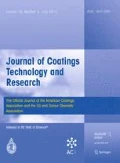Abstract
An optimized, formulated polyurethane (PU)-based insulating ink, which was inkjet printed and cured as a tri-layer on top of an inkjet-printed and sintered commercial silver ink base metal fused to polyethylene terephthalate substrate, demonstrated a resistivity of >1.2 × 108 Ω cm at a film thickness of 100 μm when exposed to an aqueous saline solution and a voltage differential of <2 V. This insulating property is highly desirable for biofluids-contacting biosensors. Three PU-based insulator ink formulations were made with different levels of ethylene glycol and carboxymethylcellulose additives to improve ink volatility, viscosity, and dispersion properties. Based on the resultant ink properties important to printing, one of these formulations was selected for further evaluation. The effects of the type and extent of surface conditioning involving UV–O3 and/or thermal treatments on print quality and completed insulator functionality are discussed. Print quality is assessed by visual and profilometry measurement.







Similar content being viewed by others
References
Ko, SH, Pan, H, Grigoropoulos, CP, Luscombe, CK, Fréchet, JM, Poulikakos, D, “All-Inkjet-Printed Flexible Electronics Fabrication on a Polymer Substrate by Low-Temperature High-Resolution Selective Laser Sintering of Metal Nanoparticles.” Nanotechnology, 18 (34) 345202 (2007)
Hackler, D, Sime, DG, Wald, SF, “Enabling Electronics with Physically Flexible ICs and Hybrid Manufacturing.” Proc. IEEE, 103 (4) 633–643 (2015)
Brand, O, Fedder, GK, Hierold, C, Tabata, O, Korvink, JG, Smith, PJ, Shin, D-Y, Inkjet-Based Micromanufacturing. Wiley, London (2012)
Dimitrakopoulos, CD, Mascaro, DJ, “Organic Thin-Film Transistors: A Review of Recent Advances.” IBM J. Res. Dev., 45 (1) 11–27 (2001)
Lin, K-T, Chen, C-H, Yang, M-H, Lee, Y-Z, Cheng, K, “Top Contact Organic Thin Film Transistors with Ink Jet Printed Metal Electrodes.” J. Imaging Sci. Technol., 51 (5) 456–460 (2007)
Ando, B, Baglio, S, La Malfa, S, L’Episcopo, G, “All Inkjet Printed System for Strain Measurement.” Proc. Sensors, 2011 IEEE, 28–31 Oct 2011
Ando, B, Baglio, S, Marletta, V, Pistorio, A, “A Contactless Inkjet Printed Passive Touch Sensor.” Proc. Instrumentation and Measurement Technology Conference (I2MTC) Proceedings, 2014 IEEE International, 12–15 May 2014
Sielmann, CJ, Busch, JR, Stoeber, B, Walus, K, “Inkjet Printed All-Polymer Flexural Plate Wave Sensors.” Sens. J. IEEE, 13 (10) 4005–4013 (2013)
Morrin, A, “Inkjet Printed Electrochemical Sensors.” Inkjet Based Micromanuf., 9 295–311 (2012)
Teng, KF, Vest, RW, “Metallization of Solar Cells with Ink Jet Printing and Silver Metallo-Organic Inks.” IEEE Trans. Compon. Hybrids Manuf. Technol., 11 (3) 291–297 (1988)
Redinger, D, Molesa, S, Shong, Y, Farschi, R, Subramanian, V, “An Ink-Jet-Deposited Passive Component Process for RFID.” IEEE Trans. Electron Devices, 51 (12) 1978–1983 (2004)
Bareiß, M, Ante, F, Kälblein, D, Jegert, G, Jirauschek, C, Scarpa, G, Fabel, B, Nelson, EM, Timp, G, Zschieschang, U, Klauk, H, Porod, W, Lugli, P, “High-Yield Transfer Printing of Metal-Insulator-Metal Nanodiodes.” ACS Nano, 6 (3) 2853–2859 (2012)
Zhou, L, Liang, D, He, X, Li, J, Tan, H, Li, J, Fu, Q, Gu, Q, “The Degradation and Biocompatibility of pH-Sensitive Biodegradable Polyurethanes for Intracellular Multifunctional Antitumor Drug Delivery.” Biomaterials, 33 (9) 2734–2745 (2012)
Lorenzini, RG, Kline, WM, Wang, CC, Ramprasad, R, Sotzing, GA, “The Rational Design of Polyurea and Polyurethane Dielectric Materials.” Polymer, 54 (14) 3529–3533 (2013)
Yi, G, Cai, F, Peng, W, He, T, Yang, X, Huang, Y, Yuan, Z, Wang, P, “Experimental Analysis of Pinholes on Electrolytic Copper Foil and Their Prevention.” Eng. Fail. Anal., 23 76–81 (2012)
Krebs, FC, “Fabrication and Processing of Polymer Solar Cells: A Review of Printing and Coating Techniques.” Sol. Energy Mater. Solar Cells, 93 (4) 394–412 (2009)
Smith, PJ, Shin, DY, Stringer, JE, Derby, B, Reis, N, “Direct Ink-Jet Printing and Low Temperature Conversion of Conductive Silver Patterns.” J. Mater. Sci., 41 (13) 4153–4158 (2006)
Ren, Y, Virkki, J, Syda, X, Nheimo, L, Ukkonen, L, “Optimisation of Manufacturing Parameters for Inkjet-Printed and Photonically Sintered Metallic Nanoparticle UHF RFID Tags.” Electron. Lett., 50 (21) 1504–1505 (2014)
Schroder, KA, NCC Nano, LLC. 200-B Parker Drive Suite 580, Austin, TX 78728, “Mechanisms of Photonic Curing™: Processing High Temperature Films on Low Temperature Substrates”. http://www.novacentrix.com/sites/default/files/pdf/Schroder-NSTI-2011.pdf (2016)
Calvert, P, “Inkjet Printing for Materials and Devices.” Chem. Mater., 13 (10) 3299–3305 (2001)
Di Risio, S, Yan, N, “Piezoelectric Ink-Jet Printing of Horseradish Peroxidase: Effect of Ink Viscosity Modifiers on Activity.” Macromol. Rapid Commun., 28 (18–19) 1934–1940 (2007)
Derby, B, Reis, N, “Inkjet Printing of Highly Loaded Particulate Suspensions.” MRS Bull., 28 (11) 815–818 (2003)
Daho, T, Vaitilingom, G, Sanogo, O, Ouiminga, SK, Zongo, AS, Piriou, B, Koulidiati, J, “Combustion of Vegetable Oils Under Optimized Conditions of Atomization and Granulometry in a Modified Fuel Oil Burner.” Fuel, 118 329–334 (2014)
Tekin, E, Smith, PJ, Schubert, US, “Inkjet Printing as a Deposition and Patterning Tool for Polymers and Inorganic Particles.” Soft Matter, 4 (4) 703–713 (2008)
Jang, D, Kim, D, Moon, J, “Influence of Fluid Physical Properties on Ink-Jet Printability.” Langmuir, 25 (5) 2629–2635 (2009)
Fujifilm Dimatix, I, “Jettable Fluid Formulation Guidelines.” http://www.fujifilmusa.com/shared/bin/Dimatix_Materials_Printer_Jettable_Fluid_Formulation_Guidelines_05-13.pdf (2013)
Author information
Authors and Affiliations
Corresponding author
Rights and permissions
About this article
Cite this article
Aminayi, P., Young, B.R., Young, T.L. et al. Inkjet printing and surface treatment of an optimized polyurethane-based ink formulation as a suitable insulator over silver for contact with aqueous-based fluids in low-voltage applications. J Coat Technol Res 14, 641–649 (2017). https://doi.org/10.1007/s11998-016-9882-5
Published:
Issue Date:
DOI: https://doi.org/10.1007/s11998-016-9882-5




